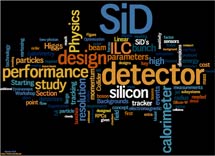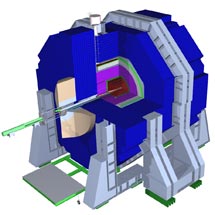
Handy Links
SLAC News Center
SLAC Today
- Subscribe
- Archives: Feb 2006-May 20, 2011
- Archives: May 23, 2011 and later
- Submit Feedback or Story Ideas
- About SLAC Today
SLAC News
Lab News
- Interactions
- Lightsources.org
- ILC NewsLine
- Int'l Science Grid This Week
- Fermilab Today
- Berkeley Lab News
- @brookhaven TODAY
- DOE Pulse
- CERN Courier
- DESY inForm
- US / LHC
SLAC Links
- Emergency
- Safety
- Policy Repository
- Site Entry Form

- Site Maps
- M & O Review
- Computing Status & Calendar
- SLAC Colloquium
- SLACspeak
- SLACspace
- SLAC Logo
- Café Menu
- Flea Market
- Web E-mail
- Marguerite Shuttle
- Discount Commuter Passes
-
Award Reporting Form
- SPIRES
- SciDoc
- Activity Groups
- Library
Stanford
Around the Bay
SiD Reaches Design Milestone
This week, scientists from around the world are gathering in Tsukuba, Japan, for a major linear collider meeting called TILC09. There, three detector design concepts for the next linear collider will take center stage. The International Large Detector, the Fourth Concept Detector (so named because it was originally the final of four detector designs), and the Silicon Detector will be presented and reviewed.
Design groups for each of the three detector concepts recently submitted Letters of Intent to the International Linear Collider Physics and Experiments Research Director, Sakue Yamada, for review by the International Detector Advisory Group. Members of this group will begin reviewing the various proposals' strengths and weaknesses at TILC09.
SLAC plays a significant role in the design of the Silicon Detector, or SiD. "Completing the LoI represents a major milestone for SiD, and is the culmination of quite a lot of work designing, costing and benchmarking the detector," said physicist John Jaros, who leads the Linear Collider Detector department at SLAC with Marty Breidenbach.
The SiD, which is smaller than the other design concepts, would use a few compact layers of silicon to precisely track and measure charged particles streaming from the collision point. These layers, which would be thinner than in any previous particle physics detector, will offer the very high resolution needed for precision measurements.
The SiD Letter of Intent describes the detector design and the types of physics for which the detector will search. It also includes results from simulations proving the detector will work, a full Monte Carlo simulation of collisions, and a simulation of the detector's particle tracking system.
"There is a level of sophistication in these documents that I think has never before been presented at this level of detector design," said Jaros. "Everyone who has worked on this deserves a lot of praise."
Writing the Letter of Intent, Jaros said, has helped to both clarify the detector design and show what more needs to be done before the full SiD proposal can be submitted a few years from now.
Read more about the detector concept Letters of Intent in the ILC Research Director's Report.
—Kelen Tuttle
SLAC Today, April 20, 2009

